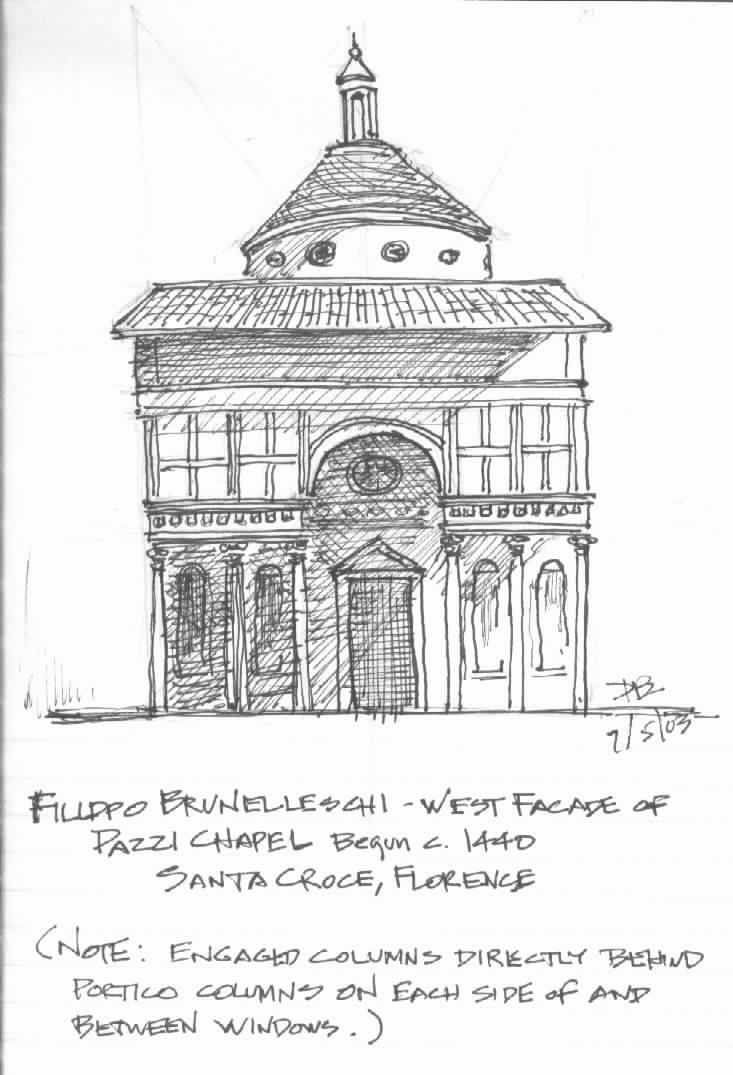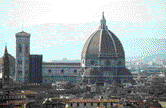2. Early Italian Renaissance Synopsis art 162 honors
Renaissance and Baroque Map
Thoroughout the early and middle decades of the 15th century (1400s, the quattrocento), Florence continued its dominance in the visual arts that had begun in the Late Gothic era and its leadership in establishing the tenets of classicism. With a patronage of art and science led and financed by the prosperous dynasty of the Medici banking family, the rediscovery and study of classical Greek philosophies and ancient knowledge helped create a new form of humanism - one that synthesized pagan mythology and Christian theology into a new viewpoint of humanity's relationship to the cosmos.
Indeed, Florence as the recognized cradle of the Renaissance, brought forth the flowering of arts and sciences that spread throughout Europe and became the foundation of our present-day, advanced technological expansion of Western Civilization. Florence's artists and philosophers, well aware of the grandeur of their achivements in parallelling those of the Greek Ancients, strove for even greater heights as they reinterpreted Classical canons and applied them to the design problems of their own age. - DJB

Pazzi Chapel, Santa Croce, Florence west facade 1440- 61
-Filippo Brunelleshci (1377- 1446)
Early Italian Renaissance 1400 - 1500
TERMS
Corinthian order - one of primary Greek architectural
styles for a trabeated construction scheme
Facade - literally, the finished face of an
object, building, or sculpture
Chiaroscuro - the painting or drawing of forms where depth and space are
illustrated through contrasting light and shade.
Relief - a sculptured form that is cut away
from its surface materal to create a facade image
Undercut - describes relief sculpture that is
severly chiseled around its contours to approach or allude to a freestanding
"sculpture in the round"
Linear perspective - representational technique
that gives the illusion of depth, where elements of an artwork are precisely
arranged pictorally in geometrically-based diagonals that converge at
vanishing points
Predella - base support and narrow ledge on
which main portion of altarpiece is seated, can be backing for painting
or series of painting separate from altarpiece painting
Engraving - method for producing multiple prints
of drawing by engraving drawing into a copper plate with sharp tools
Atmospheric perspective - representational technique
in which far distance is indicated by blurring, haze, and loss of detail
in objects in far background of artwork
Symmetry - representational technique in which
one half of artwork is mirrored in its opposite half
Contrapposto - stance of the human figure representing
"s"-curve resulting from weight shift
SLIDES
Lorenzo Ghiberti (1378 - 1455)
Sacrifice of Isaac, competition relief, 1401 - 02
"Gates of Paradise," east doors Baptistery, Florence 1425 -
52
Story Isaac and His Sons (Jacob and Esau) approx. 31” x 31”
Filippo Brunelleshci (1377- 1446)
Sacrifice of Isaac, competition relief 1401 - 02

Dome Cathedral of Florence, 140’ span 1420-36
Pazzi Chapel, Santa Croce, Florence west facade 1440- 61
Donatello (Donato di Niccolo Bardi), (1386 - 1466)
The Feast of Herod, from baptismal font of Siena, gilded bronze, c. 1425
St. Mark, Or San Michele, Marble,7’9” 1411-13
St. George, Or San Michele, Marble 6’ 10” 1415 -17
David, Bronze, 5’ 2 1/4” 1428 - 32
Equestrian Monument of Erasmo da Narni (Gattamelata% Bronze, 1445 - 50
Mary Magdalene, 1454- 55
Gentile da Fabriano (1370 - 1427)
Adoration of the Magi, Tempera on wood, 9’1 1” x 9’3”,
1423
Masaccio (Tommaso Guidi) (1401 - 1428)
Frescoes for the Brancacci Chapel, 1424 - 27
The Tribute Money 8’x 19’
The Expulsion of Adam and Eve from Eden 7’ x 2’ll”
The Holy Trinity, Fresco Santa Maria Novella, 21’ x 10’S”
c. 1428
Antonio Pollaiuolo, (1431 - 1498)
Battle of the Ten Nudes, Engraving 15” x 23” c. 1465
Sandro Botticelli, (1444 - 1510)
Birth of Venus. Tempera on canvas c.1482.
Andrea Mantegna, (1431 - 1506)
Ceiling of the Camera degli Sposi (Room of the Newlyweds), Fresco 1474
St. James Led to Martyrdom, Fresco 1455
Dead Christ, Tempera on canvas 1501
Piero della Francesca. (c. 1420 - 92)
Resurrection, Fresco 7’S” x 6’6 1/2” c. 1463
Links:
Leone Battista Alberti (1404-1472) - (brief biography)
http://www-groups.dcs.st-and.ac.uk/~history/Mathematicians/Alberti.html
Filippo Brunelleshci's Legacy in Florence: images
http://www.lib.virginia.edu/dic/colls/arh102/four/four.html
The Florence art guide
http://www.mega.it/eng/egui/hogui.htm
Madonna with the Child, Saints and Crucifixion - Fra Angelico
http://www.kfki.hu/~arthp/html/a/angelico/altar/sanmarco/altar_sm.html
Focus on Botticelli: Cyber-Ed Course, University of Mass. at
Lowell
http://www.uml.edu/Dept/History/ArtHistory/CyberEd/open.htm
http://continuinged.uml.edu/online/descriptions/58.321.htm
Sandro Botticelli
http://www.ibiblio.org/wm/paint/auth/botticelli
Univ. of St. Andrews School of Art History
Art works comparison modules
Compare Ghiberti and Donatello:
http://www-ah.st-andrews.ac.uk/under/ah1001_slides.html#3B
Old Masters at Sotheby's
http://www.thecityreview.com/w01soldm.html
Giorgio Vasari's Lives of the Artists
http://easyweb.easynet.co.uk/giorgio.vasari/vaspref.htm
University of Virginia:
Renaissance and Baroque Architecture: Architectural History 102
http://www.lib.virginia.edu/dic/colls/arh102/index.html
Renaissance art reflects the interest at the time to understand,
describe and reproduce the natural world as accurately as possible.
Source: http://www2.students.sbc.edu/hill00/seniorseminar/summary5.html
Notes:
Brunellschi's development of linear perspective based on mathematical function gave artists the tool to create an accurate illusion of spacial depth.